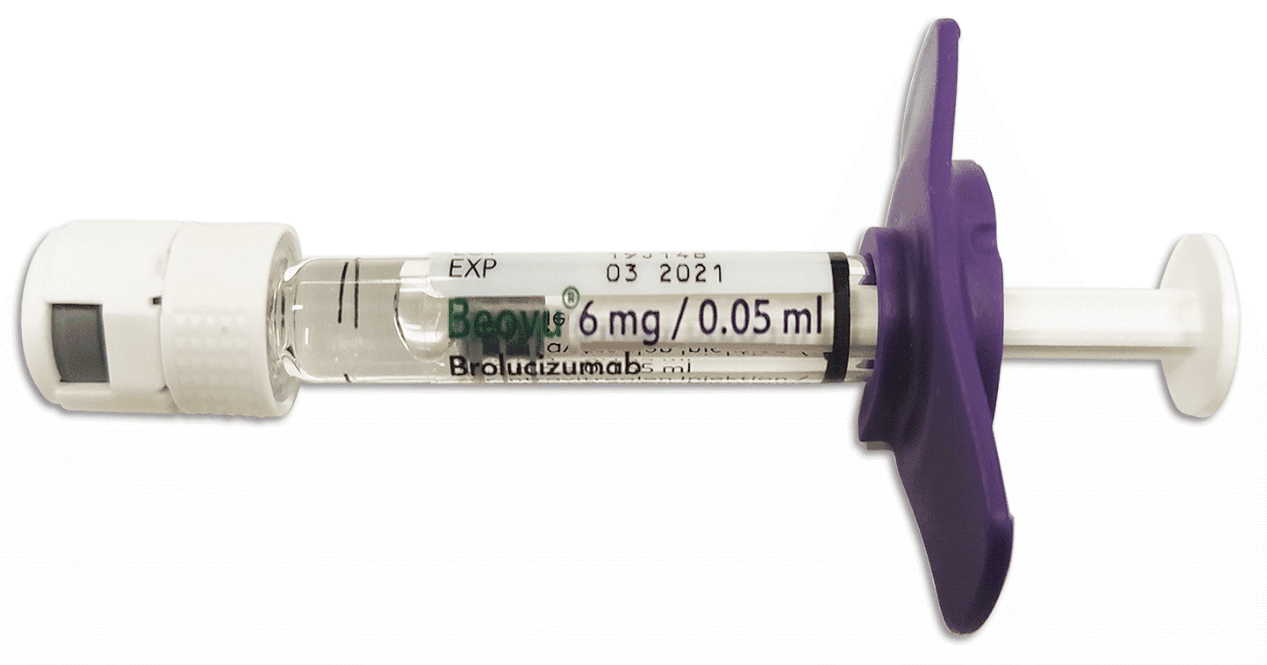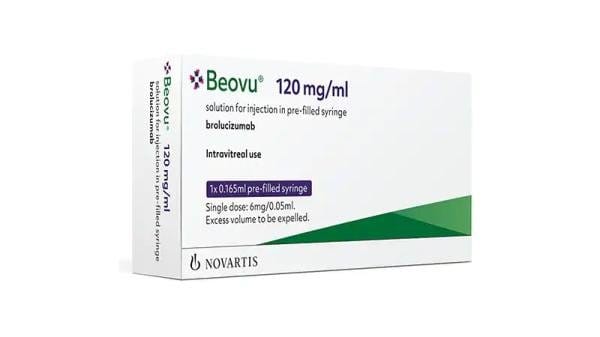Shipping with this method takes 3-5 days
Beovu® Pre-filled Syringe for Wet AMD
Stock up and Save - Get 20% off when you buy 3 or more of any one product. Use code SAVE20 at checkout.
Coupon code cannot be combined with other offers. Sale applies to all products originating from Canada. Maximum allowable quantity equal to a 90 day supply per single order.
$2,001.99
Secure Encrypted Payments
Beovu® is a prescription anti-VEGF treatment given by intravitreal injection. It is used to manage neovascular (wet) age-related macular degeneration and diabetic macular edema. This page helps you understand how the therapy works, who it suits, and how to plan access if you pay without insurance.
What Beovu Is and How It Works
This medicine contains brolucizumab, a monoclonal antibody fragment that binds VEGF-A. By blocking VEGF-A, it helps reduce abnormal vessel growth and leakage in the eye. The goal is to control retinal fluid and help stabilize central vision with a tailored injection schedule. For patients arranging refills with US delivery from Canada, the details below explain storage, handling, and coordination with your eye clinic.
YouDrugstore is a licensed Canadian pharmacy in Manitoba. Pharmacists review prescriptions before dispensing.
Brolucizumab intravitreal injection is administered by an eye care specialist under sterile conditions. The clinician uses OCT and exam findings to determine timing between doses. The prefilled syringe is single-use. It is designed to support reliable preparation and precise administration in the clinic.
Who It’s For
The treatment is indicated for adults with neovascular (wet) age-related macular degeneration. It is also indicated for diabetic macular edema when prescribed by a retina specialist. People with active ocular or periocular infections, or with active intraocular inflammation, should not receive an intravitreal injection until the condition is controlled. If you live with AMD, you can review our condition hub for context: Neovascular Age Related Macular Degeneration.
Patients with diabetes-related eye disease may find general education resources helpful alongside their clinical plan; see this awareness piece: National Diabetes Month 2025. Your retina specialist will decide if this therapy aligns with your diagnosis and ocular history.
Dosage and Usage
The injection schedule follows the official label and your prescriber’s assessment. Many patients start with a loading phase, then extend intervals based on disease activity. Your clinician will evaluate visual acuity, retinal thickness, and fluid patterns on OCT to guide timing. Brolucizumab intravitreal injection is given in a clinical setting with appropriate anesthesia and antisepsis. Do not attempt to self-inject.
After each visit, your eye care team will outline when to return. Report any concerning symptoms such as eye pain, vision changes, or increasing floaters without delay. If you wear contact lenses, follow your clinician’s instructions about when to resume use after an injection.
Strengths and Forms
The product is supplied as a single-use prefilled syringe for intravitreal use. Availability may vary by country and by wholesaler. The commonly published presentation is Brolucizumab 6 mg/0.05 mL prefilled syringe. Only a trained professional should prepare and administer the syringe.
Missed Dose and Timing
If you miss a scheduled injection visit, contact your retina clinic as soon as possible to reschedule. Do not try to adjust timing on your own. Qualitative guidance from labels emphasizes returning to the clinic so your prescriber can reassess disease activity and plan the next date safely.
Storage and Travel Basics
Pharmacies store this medicine under refrigeration and protect it from light in the original carton. Do not freeze. Keep the carton secure and out of reach of children. Do not shake the syringe. If you are traveling for an appointment, keep the carton upright and avoid excess heat. Use an insulated carrier with cold packs as instructed by your clinic. When crossing borders for care, carry your prescription and clinic appointment details.
For clinic-bound transport, maintain the package integrity and avoid punctures or crushing. If any physical damage occurs to the carton or syringe, do not use it; notify your prescriber and pharmacist. As a micro safety cue, our pharmacy uses temperature-controlled handling when required.
Benefits
This therapy targets VEGF-A, a key driver of fluid and neovascularization in wet AMD and DME. When used as prescribed, it may help reduce retinal swelling and maintain central vision. The prefilled format supports streamlined clinic preparation. After the initial phase, some patients may extend to longer intervals based on clinical response.
Side Effects and Safety
Common reactions are usually ocular and may include:
- Eye pain or discomfort
- Conjunctival hemorrhage
- Vitreous floaters
- Blurred vision
- Increased intraocular pressure shortly after injection
Serious but less common risks include endophthalmitis, retinal detachment, retinal vasculitis, and retinal vascular occlusion. Intraocular inflammation has been reported and can be vision-threatening. Arterial thromboembolic events are possible with anti-VEGF class therapies. Seek urgent care for severe eye pain, sudden vision loss, marked sensitivity to light, or rapidly increasing floaters.
If you use insulin or sulfonylureas for diabetes, hypoglycemia risk is related to those medicines rather than to ophthalmic anti-VEGF injections; still, coordinate all care with your healthcare professional.
Drug Interactions and Cautions
Systemic interactions are limited due to local ocular administration, but caution is advised with concurrent intravitreal therapies. Do not receive the injection if you have an active ocular or periocular infection or active intraocular inflammation. Tell your prescriber about prior uveitis, retinal vasculitis, or recent strokes or TIAs. Discuss pregnancy and breastfeeding plans, as clinical data are limited and risk-benefit should be assessed by your prescriber.
What to Expect Over Time
Many patients begin with more frequent visits, then move to extended intervals once the retina is drier and stable. Your clinician may adjust the schedule using OCT results and symptoms you report. Visual outcomes vary. Consistency with appointments and monitoring improves the ability to tailor the interval. Keep a simple calendar or reminder system and note any changes in vision between visits.
Compare With Alternatives
Your prescriber may consider other anti-VEGF options based on your clinical profile. Two commonly used alternatives include Lucentis Prefilled Syringe and Eylea. Differences include molecule size, dosing interval strategies, and clinic protocols. Your retina specialist will advise on the best fit for your eye, treatment goals, and visit cadence.
Pricing and Access
For patients comparing options, you can review Ophthalmology to see related therapies. If you pay cash, look for transparent estimates and ask your prescriber about scheduling that matches your disease activity. We support Beovu prefilled syringe price checks alongside clinic planning.
To understand Canadian sourcing and US delivery from Canada, our team can provide current availability and timelines to your clinic. You can also explore seasonal offers on our Promotions page. We list Beovu prefilled syringe Canadian pricing when possible and avoid surprise fees at checkout.
Availability and Substitutions
Supply can vary. If the prefilled syringe is unavailable, your prescriber may recommend an alternative anti-VEGF agent. We do not promise restock dates. Your clinic can coordinate substitution only if it is appropriate for your eye and prescription.
Patient Suitability and Cost-Saving Tips
Good candidates include adults with wet AMD or DME confirmed by a retina specialist. People with active ocular infection or inflammation should defer injections until cleared. Those with a history of inflammatory ocular events should discuss risks carefully with their prescriber.
To manage out-of-pocket spending, ask about multi-visit planning and refill timing that aligns with your injection schedule. Consider setting reminders for follow-up appointments. If you travel for care, plan refrigeration and clinic transfer ahead of time. Keep copies of your prescription and clinic contact details for quick coordination.
Questions to Ask Your Clinician
- Is this anti-VEGF therapy right for my AMD or DME?
- How long is the loading phase, and when might intervals extend?
- What symptoms after injection mean I should call right away?
- How will OCT results guide my next visit date?
- Are there specific risks for me given my medical history?
- What are the clinic’s steps to reduce infection risk?
- How should I plan storage and transport to the appointment?
Authoritative Sources
Health Canada Drug Product Database
Ready to coordinate with your retina clinic? Order from YouDrugstore with prompt, express, cold-chain shipping and US delivery from Canada. This information is educational and not a substitute for your prescriber’s advice.
Express Shipping - from $25.00
Prices:
- Dry-Packed Products $25.00
- Cold-Packed Products $35.00
Shipping Countries:
- United States (all contiguous states**)
- Worldwide (excludes some countries***)
Standard Shipping - $15.00
Shipping with this method takes 5-10 days
Prices:
- Dry-Packed Products $15.00
- Not available for Cold-Packed products
Shipping Countries:
- United States (all contiguous states**)
- Worldwide (excludes some countries***)
How is Beovu different from other anti-VEGF treatments?
Beovu is brolucizumab, an anti-VEGF agent given by intravitreal injection. It targets VEGF-A to help control retinal fluid in wet AMD and DME. Molecule design, dose volume, and interval strategies differ across the class. Your clinician will compare options such as ranibizumab and aflibercept, guided by OCT findings, safety history, and your response over time. Treatment plans may extend or shorten intervals based on disease activity.
Can I extend my injection intervals over time?
Interval extension can be possible when the retina remains dry and stable on OCT and exam. Many patients follow a loading phase, then move to longer intervals if disease activity permits. Your clinician will make these decisions at each visit based on vision, fluid, and safety considerations. Do not change timing on your own, and keep all follow-up appointments so your plan can be tailored safely.
What side effects should I watch for after an injection?
Mild discomfort, redness, small subconjunctival hemorrhage, or temporary floaters can occur. Serious symptoms include severe eye pain, sudden vision loss, marked light sensitivity, or rapidly increasing floaters. These can signal inflammation, infection, retinal detachment, or vascular complications and require urgent assessment. Follow your clinician’s aftercare instructions and call the clinic immediately if serious symptoms develop.
How should the prefilled syringe be stored before my appointment?
Pharmacies store the syringe refrigerated in the original carton and protect it from light. Do not freeze or shake. If you are transporting it to a clinic, keep it in the carton, use an insulated pack with cold sources as directed, and avoid heat exposure. Do not use the syringe if the package is damaged. Always follow your clinic’s instructions for transport and timing.
Is this medicine safe if I have a history of eye inflammation?
Discuss prior uveitis or retinal vasculitis with your prescriber before starting therapy. Anti-VEGF injections can rarely be associated with intraocular inflammation, retinal vasculitis, or vascular occlusion. Your clinician will weigh potential benefits and risks, consider your history, and may recommend a different option if the risk seems higher. Report any unusual symptoms promptly between visits.
Will this interact with my other medications?
Because the injection is given into the eye, systemic drug interactions are limited. Still, share your full medication list and medical history with your clinician. Concomitant intravitreal therapies or recent ocular surgery may influence timing. People with recent stroke or TIA should discuss the anti-VEGF class warning on arterial thromboembolic events with their prescriber.
Can I travel with this medicine before a clinic visit?
If instructed to bring the syringe to a clinic, plan ahead. Keep it refrigerated in the original carton, use an insulated carrier with cold packs, and avoid heat and shaking. Carry your prescription and clinic details, especially if crossing borders. Allow extra time at security checks, and do not open the carton until the healthcare professional is ready to prepare the injection.

